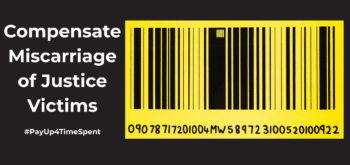This week the Centre for Crime and Justice Studies published a second edition of the Usual Suspects, a report which looks at the best available indicators of joint enterprise prosecutions and convictions for over a decade.
Seven months on from our original report, why are we releasing a second edition?
The short answer is because we realised we did not get everything quite right the first time round. And in a subject as opaque and controversial as joint enterprise, clarity is much needed.
Secondary suspects
There are no changes to our substantive findings (covered by The Justice Gap here). The data, obtained through freedom of information requests to the Crown Prosecution Service and the Home Office, also remains the same. As do our key recommendations and messages.
What has changed is adding a definition for a key source we used to assess the use of joint enterprise: the number and demographics of ‘secondary suspects’.
We used secondary suspects as one of the best available approximations about the use of joint enterprise laws. Which it is. But our original report did not clarify who a secondary suspect is.
Secondary suspect is a term used in the Home Office’s Homicide Index. It applies to those who are prosecuted, and (somewhat confusingly to common parlance) to those who are convicted, of a homicide offence, in multi-defendant cases, excluding one person. Excluded is the person deemed by the police to be the most involved in the homicide or to have had the closest relationship to the victim, or, in the case of conviction, the person who received the longest sentence, or most serious conviction. The excluded person is termed the principal in the Home Office Index. Only one principal can be identified per homicide victim.
The importance of this distinction for those looking to understand the use of joint enterprise, is that secondary suspect is not a definition of secondary liability. It includes all circumstances in which two or more people are prosecuted or convicted in relation to the same homicide, so includes joint principals in common – those deemed equally culpable for an offence, not only those charged or found guilty as an accessory or secondary.
Opaque practices
It is not known with certainty how many people are currently imprisoned for murder because they were deemed a secondary or accessory, rather than the principal offender.
It is not known because it is not recorded. One reason given for this lack of recording is that it is too difficult a task.
True, no one is convicted of joint enterprise. An individual is prosecuted for an alleged offence which must be defined. The basis for their being held responsible and culpable, whilst essential to their prosecution and potential conviction, does not have to be similarly distinguished.
But this seems more of a convenient obstacle than an insurmountable one.
When multiple individuals are being charged in relation to the same homicide, if the person deemed by the police to have had the closest relationship to the victim can be recorded, surely some key indicators regarding the grounds for being held responsible and culpable for the offence can be too?
The Justice Committee thought so, and recommended improved data collection as part of their inquiry into joint enterprise back in 2012. Researchers who accessed Crown Prosecution Service case files as part of an exploratory study of the use of joint enterprise thought so too. Their report, also now published some years ago, in 2016, sets out a number of practical ways better data collection could be achieved. They include:
- Adding a question about whether someone is charged as a principal, an accessory, or as either a principal or accessory.
- Identifying the basis for charging an accessory. Including recording when an individual is deemed to have assisted an offence without being present.
- For homicide offences it would also be valuable and feasible to record the reason why alternative (lesser) charges were not pursued for those charged as accessories.
Historic injustice
In addition to improved data collection about current practices, better information about historic practices should not be overlooked.
In 2016 the law on secondary liability was found to have taken a ‘wrong turn’ for over thirty years regarding the application of ‘parasitic accessorial liability’, or foresight for another’s actions. Yet no retrospective assessment has been made about the number or proportion of individuals imprisoned for murder and manslaughter following a multi-defendant case where parasitic accessorial liability or foresight was cited.
Towards accountability
Gloria Morrison, from the campaign group JENGbA recently gave an update about the legal action JENGbA is taking against the Crown Prosecution Service in the hopes of securing the now long promised better data collection about joint enterprise. Let’s hope they succeed. Better data collection is both eminently possible and essential to holding these unjust laws to account.







